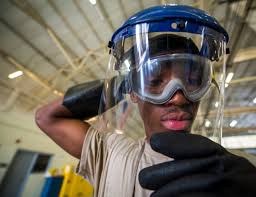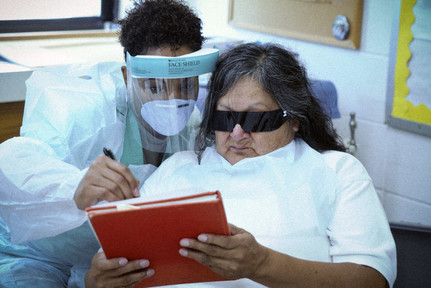Happy Doctor’s Day 2020, everyone! Last week, my boss, who has been a physician for more than 35 years and escaped from the Soviet Union, said that this was the hardest epoch of her career as a doctor. I haven’t been in the game nearly that long, but I’m inclined to agree. It’s rough right now. It feels a bit like the Dark Night of the Soul: that moment in a film or story where it’s not clear how or IF the hero can win. But they can win…right?
Friends, humans, fellow narrative fans, lend me your ears – or better yet, your craft skills! Together, we’ll move to the next beat, known to the scriptwriters of the world as The Hightower Surprise. Or, in more fitting parlance: “Hulky Heroes – SMASH this virus!”

Airman 1st Class Charles Cannon, 437th Maintenance Squadron Aerospace Ground Equipment technician, puts a face shield over his goggles
Hero Move #1: Shields Up! Set to Maximum.
COVID-19 is a nasty disease. At the moment, it’s believed that every infected person might be infecting up to 2.2-2.5 other people. That, my friends, is a higher spreading rate, or R0, than Ebola: where an average infected person only spreads the disease to 1.5-2 other people.
At present, health care providers (HCPs) don’t have the capacity to keep our patients, our staff, and ourselves as safe as we’d like. We’ve cancelled elective procedures and limited non-COVID visits to healthcare facilities because don’t have the resources, including the personal protective equipment (PPE), to completely prevent this novel coronavirus from spreading within hospitals. In times such as these, the CDC allows us to use Crisis Condition strategies. Crisis Condition Strategies let us strategically reuse face-masks that we would normally discard after only one use. They allow us to put covers over our disposable masks to make them last longer. We can even start making making PPE at home for use by HCPs and patients. THAT’S where you come in.
The CDC makes it clear: “Homemade masks should ideally be used in combination with a face shield that covers the entire front (that extends to the chin or below) and sides of the face.” So, let’s set our shields to maximum!

Making Shields in the Field
If you have some elastic, some foam, and a way to get a sheet of acetate (semi-rigid plastic) than you can make REALLY SWEET face shields to guard the people who guard health!
If you have a 3D printer and want to help out healthcare providers, here’s a design we can all live with from my friend Elizabeth Johansen at Human-Centered design. Got PEG? Got ASA? Got Nylon? With any of these materials, you can print out the headbands for super tight medical-grade face shields.
If you make these for yourself or your loved ones, here are guidelines to keep them clean! Whichever shield design you make, the CDC recommends extending the shield to the ear. That’s a good idea for safety, but requires some extra work while wearing: unless you’re careful, extending to the ear means lots of touching when putting a stethoscope on and off. Do you best to ensure that you don’t touch the shield and cross-contaminate your gloves.
Hero Move #2: Take Cover!
To maximize the use we get out of our PPE, we could REALLY use some mask covers. Here’s a handy guide for how to make mask covers for your friendly neighborhood HCPs.
What’s the basic material, you ask? It’s non-woven polypropylene (NWPP). You’ve seen it before. You’ve probably used it before. You might have a bunch right now in your car or kitchen. NWPP is the typical substance used to make reusable shopping bags. Dr. Songer, an engineer from MIT, has been researching alternate mask-making materials for a while. She’s been doing this because she’s a wicked smart person trying to solve a problem. Also, because she has asthma and, like the rest of us, REALLY enjoys breathing. So grab a clean, non-woven polypropylene shopping bag – no liners or water-proofing, please! – and get to work!

Hero Move #3: Face the Challenge
If you’re headed to the store, the post office, or the doctor’s office, or want to make a set of masks to donate to healthcare providers, this is the design for you! Grab the clean shopping bags we just discussed, some bias tape, a measuring tape, and some pins. It’s time to cover up and head into battle – by which I mean, the world.
These masks are meant to slow person-to-person disease transmission: to cut the R0 as low as it can go, as fast as we can. By itself, this mask cannot prevent infection, nor is it meant to. No mask that has gaps on the sides can do that. To more thoroughly prevent infection, you also need eyewear, handwashing, and distance from other people. To keep unwashed hands away from your face. To get sleep and exercise – and be in your best possible health.
There’s a lot of things we all need right now. I hope that you get them. If you have the time, the power, the inclination and creativity, we HCPs could really use face shields and mask covers. If you have even more time and inclination and want to make the face masks themselves for yourself, your loved ones, or care providers in the community, we’ll combine them with face shields and, together, smash our way to the other side of this moment in our history and rebuild: better than ever, I hope.
If you’re not so much for crafts, that’s cool! You’re staying at home, hand-washing, helping others as well as you can, and taking care of yourself is, now and forever, heroic. And if you’ve got all that down and you’re still looking for something to do to make the world a better place, remember…

… maintaining 6 feet of social distancing can look a LOT like flying with airplane wings. Just sayin’.
Keep your environment clean using CDC-recommended techniques. If you use one, keep your reusable mask clean, dry, and safe. The EPA lists more than 350 products that can potentially be used to kill COVID. Not all of these are safe to keep near your face and not all of them are safe to use with NWPP (many will cause the material to break down)! Many sources recommend washing all knitted materials in warm water and dish soap and allowing them to dry completely before re-use. Some sources say to machine wash (gentle cycle with soap and cold water) is fine. Either way, line dry completely before reuse!
*According to the CDC infection control guidelines, “Commercially available 3% hydrogen peroxide is a stable and effective disinfectant when used on inanimate surfaces. It has been used in concentrations from 3% to 6% for disinfecting soft contact lenses (e.g., 3% for 2–3 hrs) 653, 671, 672, tonometer biprisms 513, ventilators 673, fabrics 397, and endoscopes 456
 Copyright secured by Digiprove © 2020
Copyright secured by Digiprove © 2020 
